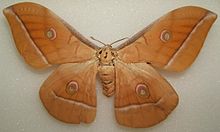- Antheraea pernyi
-
Antheraea pernyi Mounted female 
Living specimen Scientific classification Kingdom: Animalia Phylum: Arthropoda Class: Insecta Order: Lepidoptera Family: Saturniidae Tribe: Saturniini Genus: Antheraea Species: A. pernyi Binomial name Antheraea pernyi
(Guérin-Méneville, 1855)Synonyms - Antheraea hartii
Antheraea pernyi, the Chinese (Oak) Tussah Moth (or "Chinese Tasar Moth"), also known as Temperate Tussah Moth, is a large moth in the family Saturniidae. Antheraea roylei is an extremely close relative and the present species might actually have evolved from ancestral A. roylei by chromosome rearrangement.[1]
They are originally from southern China. Used for tussah silk (a wild silk) production, they have been distributed more widely across subtropical and tropical Asia. Unlike the Domestic Silkmoth which is entirely dependent on human care, tussah silkmoths can survive in the wild if they escape from captivity; small local populations of such feral stock may thus occasionally occur. The colour and quality of the silk depends on the climate and soil.[2]
This is one of the major producers of tussah silk. It was of commercial importance during the Han Dynasty and early Three Kingdoms era, about 200 BC to 250 AD. More recently, the hybridogenic species Antheraea × proylei is being bred for tussah silk production. It originated from a natural hybrid between male A. pernyi and A. roylei females, F1 females of which were backcrossed to A. pernyi males. For reasons unknown, it is a case of paternal mtDNA transmission: the mitochondrial genome, normally inherited from the mother only in sexually reproducing organisms, is almost identical to that of the present species.[1]
Contents
Gallery
-
1st instar caterpillars
Footnotes
- ^ a b Arunkumar et al. (2006)
- ^ "CHAPTER 9". Fao.org. http://www.fao.org/docrep/005/y4351e/y4351e0d.htm. Retrieved 2011-10-18.
References
- Arunkumar, K.P.; Metta, Muralidhar & Nagaraju, J. (2006): Molecular phylogeny of silkmoths reveals the origin of domesticated silkmoth, Bombyx mori from Chinese Bombyx mandarina and paternal inheritance of Antheraea proylei mitochondrial DNA. Molecular Phylogenetics and Evolution 40(2): 419–427. doi:10.1016/j.ympev.2006.02.023 (HTML abstract).
- North-Szigetváry, L. (1894): “The Japanese and Chinese Oak-Silk Spinner : Their Life and Cultivation (Attacus Jama-mâi and Bombyx Pernyi).” L. North-Szigetváry, of Newchwang. The Journal of the Manchester Geographical Society. 1894. Vol. 10. Nos. 4-6 April to June, pp. 183-193.
Supplementary figure 1 (JPG) Supplementary figure 2 (JPG) Supplementary figure 3 (JPG)
External links
- Life Cycle Warning: Many images, may require a lot of bandwidth
- http://www.cdfd.org.in/wildsilkbase/info_moths.php

This article on a moth of the Saturniidae family is a stub. You can help Wikipedia by expanding it.









